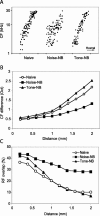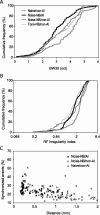Progressive degradation and subsequent refinement of acoustic representations in the adult auditory cortex
- PMID: 14645468
- PMCID: PMC6740992
- DOI: 10.1523/JNEUROSCI.23-34-10765.2003
Progressive degradation and subsequent refinement of acoustic representations in the adult auditory cortex
Abstract
Correlated neuronal activity is believed to play an important role in refining and maintaining cortical circuitry during early development. Here we provide evidence that globally and locally correlated activity mediate different forms of adult plasticity. Pulses of broad-spectrum noise were used to activate time-locked responses across large areas of the rat auditory cortex, globally synchronizing cortical activity. Brief tone pips were used to activate relatively small groups of neurons, generating locally correlated activity. Pairing pulsed noises with nucleus basalis (NB) stimulation in awake rats for 4 weeks broadened spectral tuning, disrupted tonotopic maps, and reduced spontaneous discharge correlation in the primary auditory cortex (AI), as examined under anesthesia. Those effects caused AI neurons to appear qualitatively similar to neurons in nonprimary auditory fields of naive animals. Subsequent pairing of tone pips with NB stimulation for a period of 4 weeks completely reversed these effects induced by previous noise-NB pairing. These findings further demonstrate that the adult auditory cortex retains a substantial capacity for receptive field plasticity and tonotopic map reorganization and that locally correlated activity plays an important role in plasticity in the adult, as in the developing cortex.
Figures








References
-
- Ahissar E, Vaadia E, Ahissar M, Bergman H, Arieli A, Abeles M ( 1992) Dependence of cortical plasticity on correlated activity of single neurons and on behavioral context. Science 257: 1412-1415. - PubMed
-
- Arnold HM, Burk JA, Hodgson EM, Sarter M, Bruno JP ( 2002) Differential cortical acetylcholine release in rats performing a sustained attention task versus behavioral control tasks that do not explicitly tax attention. Neuroscience 114: 451-460. - PubMed
-
- Bakin JS, South DA, Weinberger NM ( 1996) Induction of receptive field plasticity in the auditory cortex of the guinea pig during instrumental avoidance conditioning. Behav Neurosci 110: 905-913. - PubMed
-
- Bao S, Chan VT, Merzenich MM ( 2001) Cortical remodeling induced by activity of ventral tegmental dopamine neurons. Nature 412: 79-83. - PubMed
Publication types
MeSH terms
Grants and funding
LinkOut - more resources
Full Text Sources
Other Literature Sources
